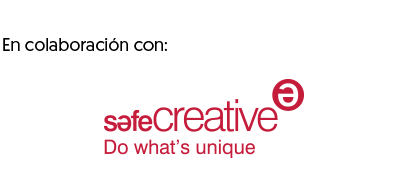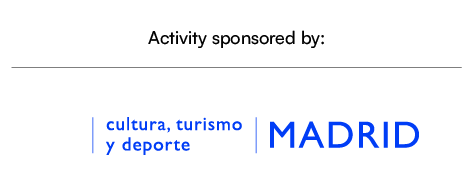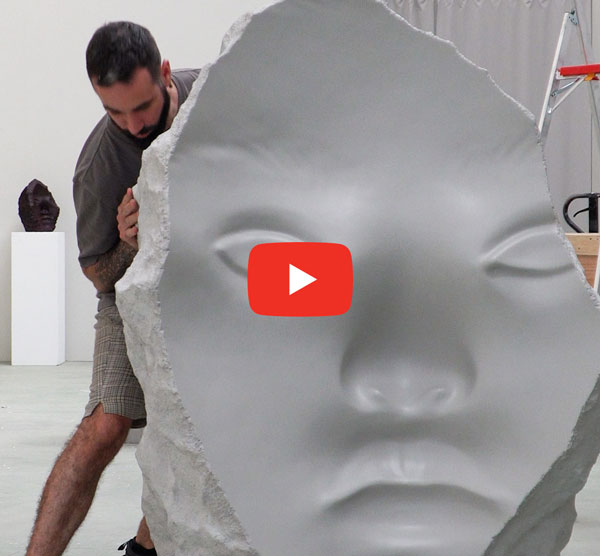ALEJANDRO MONGE: CHRONICLER OF HIS TIME
Feb 15, 2024
art madrid
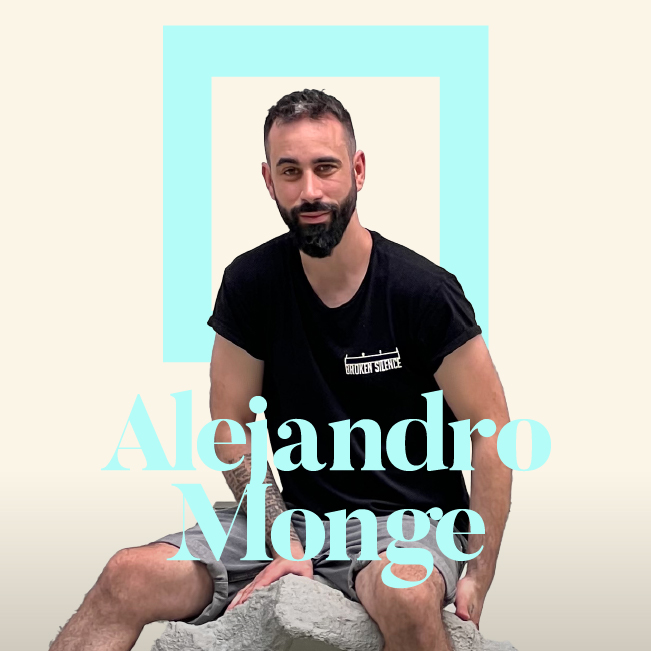
ARTE & PALABRA. CONVERSATIONS WITH CARLOS DEL AMOR
It is difficult not to stop in front of the works of Alejandro Monge (Zaragoza, 1988), but beyond the initial legitimate curiosity, we discover characters about whom we ask ourselves questions: where they come from, where they are going, what they observe, what they listen to, what they think. There are few certainties and many questions to be answered, perhaps because for Monge the future is a place full of questions and therefore worries, and perhaps also, or perhaps not, because it is the only place where we are constantly moving. We may not know where we are going, but we are always moving towards tomorrow, and that tomorrow is the territory towards which his sculptures move.
It is curious, we can say that his creations are very realistic and yet they have something that separates them from what we know and takes them to an alien terrain. They exist, but they are not part of this world, they seem to come from another and they seem to know more than we do about what awaits us. In some of his latest hypnotic works, we see only faces emerging from the bottom of a cement block, hard and fragile at the same time, and these creatures seem to be in an amniotic state, peaceful, oblivious to the future that will probably betray them as soon as they hatch.
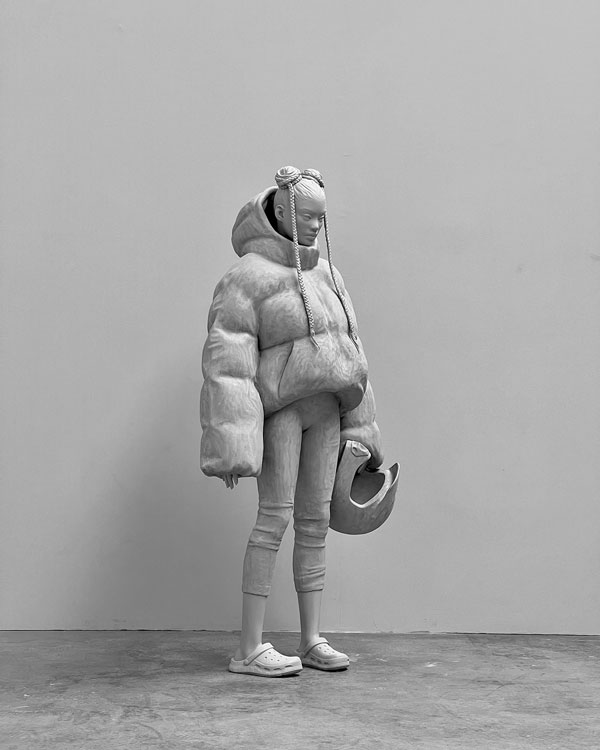
If you had to define yourself in one sentence, which one would you use?
I'm quite nonconformist, demanding in my work and I really like challenges. Technically I work a lot to try to surprise and create new things that surprise me. I try to talk about two main things: destruction as a new form of creation - something I have dedicated a lot of my artistic career to - and now I am very focused on my generation. It's something that interests me more and more every day. I want to represent the generation in which I live, to be a child of my time, and to one day see myself as a chronicler of my time. Maybe that is what motivates me the most today.
Where do the characters in your plays go, what is their future?
I develop them more and more every day. Especially in the last two years, I have created characters that represent my generation. That's why I want them to have classic icons of the era I lived through, combined with other elements that don't have to be current. I also want to give more context to my work and I think that is where the future is going. I'm going to try to make big, very big pieces, with installations that not only represent a character, but also what surrounds him. And although it's complex, because technically it requires a lot of work, a lot of sacrifice, technical means, materials... that's the way I'm going to go. Let's see how it goes.
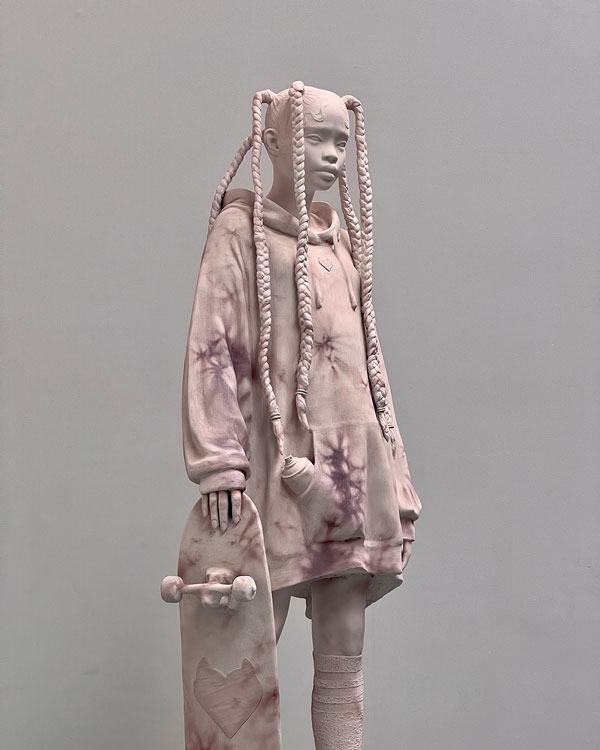
The future is an unknown place and I don't know if that's why, out of irresponsibility, we seem to worry little about it... Your work reflects a concern for that future, doesn't it?
Yes, actually my work is always about the future and the history we leave behind, it's a chronology in the end. Ever since I was a child I've always been interested in what's going to happen, and nowadays it's something I'm developing more and more. But I wouldn't say that I'm worried about the future, although it's true that I think there's a certain psychosis that the future is going to be terrible, catastrophic, and that everything is going to happen. But in reality my vision is a bit more optimistic, isn't it?
There is, it seems to me, a sense of legacy in the discipline of sculpture, of "leaving something on carved stone". Perhaps the first sculptures, not strictly speaking, were the footprints carved into the ground, the footprint. Is the footprint directly related to the future? Will we emerge well from the footprint we leave today?
I think that every generation has had its lights and shadows, and at every moment people have thought that it was the worst in history, that something terrible was coming, the seven plagues... But I think we are more prepared than ever for the future. Are we going to do well or badly? Well, some things we will do better or worse, but in my work I don't speak of a concern for the future, I speak of a concern, a curiosity. What does the future have in store for us? What will our society look like? What will our generations look like? So I think that what is beautiful in art, or what I try to deal with in my work, is more about asking myself: what mark do we leave in history, how will we be remembered in the future? That's something that interests me and that's the goal I'm most focused on right now, to be able to do my part and be a chronicler of my time, reflecting my generation.
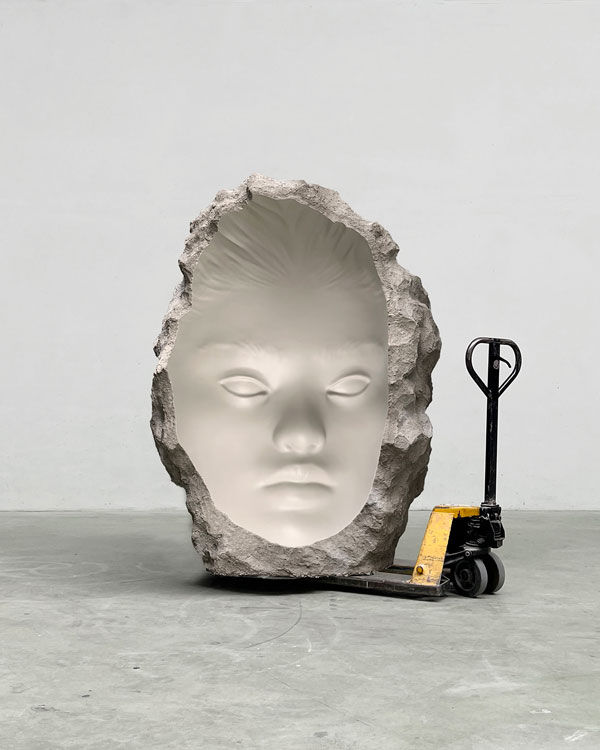
Eyes open or eyes closed? Walking through your works, we can see that many of them have their eyes open, although I don't know if open means they can see, and others have their eyes closed.
I do both open-eye and closed-eye works, and although I was going to say that I like one more than the other, I don't think so, because they reflect different things. When a figure has its eyes closed, it is much more reflective, it is in a dreamlike world, it is more neutral, it conveys more calm and peace. In sculpture, representing open eyes is very complex because the eye is a crystalline lens, it's something that can't be represented sculpturally; like fire or smoke, which are not elements that you can sculpt or model. But I think this way of representing it, full eyes without pupils, is a more modern way of representing it than the way it was done in the past, when the eye was trepanned and a little dot was created in the pupil. I'm not interested in that anymore. I think it's something that makes the sculptures very hieratic, something fixed in time. But these eyes that I make, which are certainly more personal, are a bit disturbing, there are even people who don't like them because they give the feeling that they are piercing you with their gaze. But since I've talked a lot more about open eyes than closed ones, maybe I like them more.
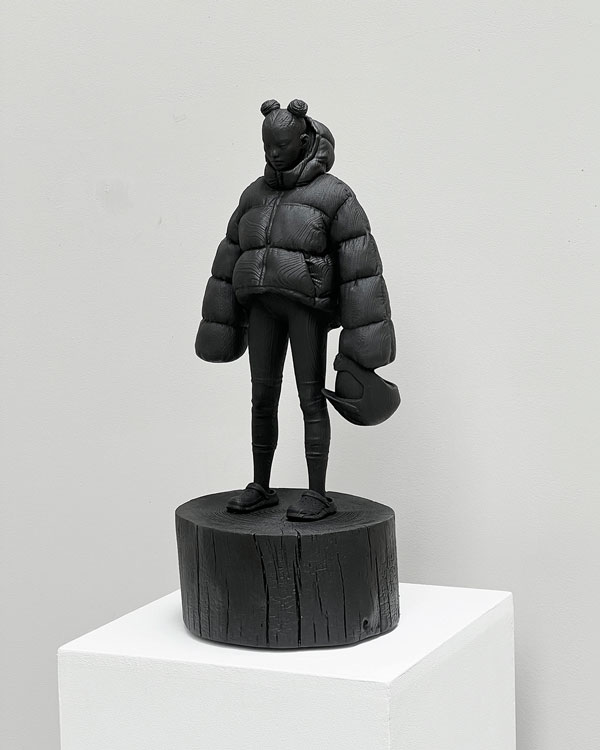
At a fair, the artist can see the reactions of the public, in your case, your work attracts a lot of attention, it is usually a meeting point. What do you feel when you see these reactions?
Well, fairs are something that I personally love. Ever since I went to Art Madrid for the first time years ago, I've always loved going to all the fairs. I like being there. If there's a fair, wherever it is in Spain or in the world, I go and I enjoy it a lot because it allows you to get to know. Both to get to know the gallery that represents you better and to get in touch with other artists, new artists you didn't know, artists you've been friends with for ten or twelve years, but above all it allows you to see how the public interacts with your work. That's something I'm very interested in, because an artist spends a lot of time in his studio, locked away, and has almost no feedback. But when you come to a fair and see all the work together, it's like the reward for so much time invested. The moment comes and suddenly it all happens in a week, you can see thousands of people coming to see your work. And, well, I like to stand off to the side and listen, because nobody knows I'm the artist, so I put my ear to the ground and listen a bit to what they're saying.
I think the main interest of your work at a fair is that it doesn't go unnoticed, because there are a lot of stimuli, a lot of competing works, and the public sees them quickly. That's why I always focus on bringing very striking pieces that attract a lot of attention. In general, I like fairs a lot and I have a lot of fun wherever they are, I'll tell you, this year, for example, I've been to Kiev, to Korea, to Shanghai, I've been to Art Miami, I've been to Art Madrid, and the truth is that I love it. Wherever there's a fair and there's a work of mine, I try to be there whenever I can.

Are you more artistically inclined to sculpture than painting, or does it depend on the moment in life?
Which gives me more pleasure, painting or sculpture? To be honest, I'm more into sculpture. I am a sculptor. I actually started out as a painter, but I studied sculpture. It's a bit ironic, isn't it? I was 100% self-taught in painting, because I didn't study fine art, but I did a degree in sculpture, where the sculptural knowledge they give you isn't enormous either, it's very basic, nothing out of this world.
Nevertheless, I've always been more interested in sculpture. I think because it has more possibilities and aspects. When you make a sculpture you can go in many directions, you can create materials and develop your own sculptural processes. You use a lot of techniques, materials and tools. There are parts that are design and parts that are modelling, every day you're doing something different and it's also less exploited. Let's say you can be much more innovative in that sense. At least for me, that's what I like the most. I get bored easily and I'm always looking for a challenge. That's why I think there's a greater technical and also creative challenge in sculpture, because it gives you almost unlimited possibilities, I would say.
I love painting and I've been painting for many years. Also, I have done hyperrealism, which is a very complex technique, which is technically very demanding because there is no room for failure - I always say that when you do realism it is very difficult to hide the fact that something is wrong, you have to do things very technically correctly. But it's also true that the process of painting bores me more because it makes me more still, more paused. It's painting, a canvas... it's something more reflective, and maybe I'm more dynamic and experimental. That's why I'm a sculptor.
Where do you think your art is going?
I think my work, especially recently, has been moving towards large works. I've always liked large format, but more and more. All the ideas and all the new projects I have for next year and even more in the long term are large format projects. I'm also looking at installation, which is something I haven't developed enough and I'm determined to do. Technically, I want to make the pieces more complex. They're already quite complex, but I want to go a bit further, especially in terms of materials, and I'm trying to create my own. Sometimes it is impossible, but there is a certain margin to create materials that can be cements with additives or with pigments. I am also trying to recover ancient techniques from the 16th century that are very lost, some sculptural techniques that used to be made with marbling, and I am trying to combine them with other current techniques and materials that give me different results, which is what I am looking for. I want the material to be the hallmark of my work and I want the work to be more contextual, not just a character, but to create an atmosphere. I think that's where I'm going, let's see how it goes.
